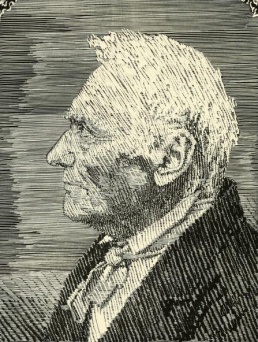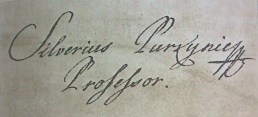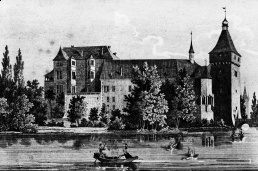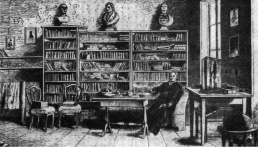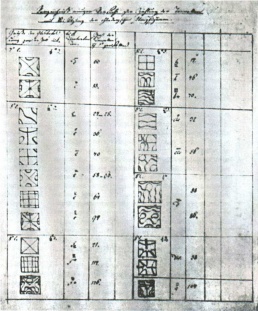Difference between revisions of "Jan Evangelista Purkyně"
| Line 8: | Line 8: | ||
|death_place = [[Prague]], Austria-Hungary | |death_place = [[Prague]], Austria-Hungary | ||
}} | }} | ||
| − | [[Image:Purkyne_drawing.jpg|thumb|258px]] | + | [[Image:Purkyne_drawing.jpg|thumb|258px|Illustration by František Bílek, in ''Sebrané spisy, Vol. 1'', 1918.]] |
Jan Evangelista Purkyně (Johann Purkinje) was a 19th-century physiologist, anatomist, biologist, poet and philosopher. His experimental physiological investigations in the fields of histology, embryology and pharmacology helped to create a modern understanding of the eye and vision, brain and heart function, mammalian reproduction and the composition of cells. Purkyně created the world's first department of physiology and was one of the best known scientists of his time. He was a member of the Academies of Sciences in Berlin (1832) and Vienna (1860), of the Royal Society in London (1850), and corresponding member of the Academies of Sciences in St. Petersburg (1836) and Paris (1861). | Jan Evangelista Purkyně (Johann Purkinje) was a 19th-century physiologist, anatomist, biologist, poet and philosopher. His experimental physiological investigations in the fields of histology, embryology and pharmacology helped to create a modern understanding of the eye and vision, brain and heart function, mammalian reproduction and the composition of cells. Purkyně created the world's first department of physiology and was one of the best known scientists of his time. He was a member of the Academies of Sciences in Berlin (1832) and Vienna (1860), of the Royal Society in London (1850), and corresponding member of the Academies of Sciences in St. Petersburg (1836) and Paris (1861). | ||
| Line 15: | Line 15: | ||
==Life== | ==Life== | ||
===Early years=== | ===Early years=== | ||
| − | J. E. Purkyně was born on 17 or 18 December 1787 in Libochovice, a small village in northern Bohemia (then part of the Austrian | + | J. E. Purkyně was born on 17 or 18 December 1787 in Libochovice, a small village in northern Bohemia (then part of the Austrian Empire, now Czech Republic), as the first son of economic supervisor of the estate of Dietrichsteins, Josef (1746–29.9.1793) and Rosalia (born Šafránková, 1756–1834) Purkyně, followed by Emanuel (24.12.1789-28.5.1791) and Josef Jindřich (12.7.1793–1833). His father died suddenly in 1793. This affected the economic status of the family, and Jan's opportunity to acquire higher education was endangered.<ref>{{harvnb|Franta|2011|p=198}}</ref><ref>{{harvnb|Kruta|1985}}</ref><ref>{{harvnb|WadeBrožek|2001|p=27}}</ref> |
| + | |||
| + | ; Early studies | ||
| + | Jan received the foundations of general education in the Czech primary school of Libochovice. The inquisitive child widened his horizons by reading Comenius' ''Orbis Pictus''. The local chaplain, Father Schiffner, was impressed by the child's intelligence and introduced him to Latin. He also taught him the Greek alphabet and spoke with him about astronomy. In the school Jan was introduced to music, both vocal and instrumental. He sang well and learned to play violin. As it turned out, these skills, especially singing, were of critical importance for the continuation of his education.<ref>{{harvnb|WadeBrožek|2001|p=27}}</ref><ref>{{harvnb|Franta|2011|p=198}}</ref> | ||
| + | |||
| + | In the spring of 1798, with the help of his mother's friends, Jan was accepted as a member of the church choir in Mikulov, southern Moravia. This enabled him to attend the school (later followed by his brother Josef), established for the Piarist order by Cardinal Dietrichstein, without paying the relatively high tuition fees. The language of instruction was German. The study program involved 3 years of the so-called normal school and 5-year gymnasium. At the gymnasium, the curriculum included Latin, Greek, history, and geography. In contrast to other comparable schools, at this gymnasium the Piarists paid substantial attention to philosophy, modern languages, mathematics, and physics. The Mikulov school had a rich collection of astronomical and physical apparatus. In its library he acquainted himself with the writings by G. Dobner and S. Konarski. There he probably found Schiller's poems, his lifelong passion. Jan did well in the normal school and was one of the best students at the gymnasium; he completed his studies there in 1804.<ref>{{harvnb|WadeBrožek|2001|p=27}}</ref><ref>{{harvnb|Franta|2011|p=198}}</ref> | ||
[[Image:JE_Purkyne_signature_1806.jpg|thumb|258px|Purkyně's signature in 1806.]] | [[Image:JE_Purkyne_signature_1806.jpg|thumb|258px|Purkyně's signature in 1806.]] | ||
| − | + | In order to be able to continue his schooling, Purkyně applied for admission to the Piarist order, was accepted and adopted name Silverius. For his novitiate he journeyed to the monastery Stará Voda, near Olomouc, in north-central Moravia. Here he strengthened his knowledge of some subjects that were taught in the gymnasium and also learned French and Italian, completing his studies in two instead of three years. In 1805 he began to teach at the Piarist school (nižší gymnázium) in Strážnice (where [[Jan Amos Comenius]] studied in his time), southern Moravia, and in the following year he moved to the Piarist college in Litomyšl, eastern Bohemia. During the school year 1806–7 he simultaneously taught at the normal school and studied philosophy; the latter was at a school training future gymnasium teachers as well as students planning to study law, medicine, or theology. The library of the monastery of Olomouc offered rich treasures; among the major German thinkers, Kant remained unappealing to Purkyně whereas Schelling's ''Naturphilosophie'' [Philosophy of Nature] interested him throughout his life; however, it was Fichte who affected him most profoundly, especially through ''Einige Vorlesungen über die Bestimmung des Gelehrten'' [Some lectures on the mission of a scholar] (1794) and ''Uber die Bestimmung des Menschen zur unbeschränkten seelischen Freiheit'' [The call of men to an unlimited mental freedom] (1800).<ref>{{harvnb|WadeBrožek|2001|pp=27-28}}</ref><ref>{{harvnb|Franta|2011|p=198}}</ref> | |
| − | Purkyně | ||
| − | + | The German philosophers were not the most appropriate reading matter for a thoughtful young cleric who was a member in the Piarist order. Purkyně himself, in his midseventies, remembered the impact of Fichte’s philosophy as follows: "Having become somewhat familiar with the state of the newer literature in Germany and in other cultured countries and admiring their top contributors as well as getting to know the fate of my aging colleagues in the monastery, exhausted from an early age by strenuous teaching, I was frightened that a similar fate would await me as well"<ref>{{harvnb|Rieger|1867|p=1115}}</ref>. Fichte's philosophy vividly portrayed the mission of a true scholar in human society and rallied the human mind to an unlimited freedom. In combination with this familiarity with Fichte, Purkyně began to think of a different, happier life with enough strength to establish an independent position in the world: "Yes, the desire of glory strongly impelled me to follow my own path. Having been concerned in the monastery only with philological and historical studies, I turned first to poetry and then to philosophy whose spirit would free my mind. Yes, I felt deeply that I could achieve something significant in natural sciences, about which of course I had only a vague idea"<ref>{{harvnb|Rieger|1867|p=1115}}</ref>. These thoughts moved Purkyně to leave the Piarist order in August 1807, after which he took a pilgrimage walk home (Litomyšl, Vysoké Mýto, Přelouč, Praha, Radovesice, Libochovice). The chronicle of the monastery at Litomyšl contains a brief record of his decision: "Clericus Silverius Purkinie deserto Instituto nostro ad parentes Libochovicium migravit" (Having left our institution, the Clericus Silverius moved to his parents in Libochovice).<ref>{{harvnb|WadeBrožek|2001|p=28}}</ref><ref>{{harvnb|Franta|2011|p=198}}</ref> | |
===First Prague period (1807–23)=== | ===First Prague period (1807–23)=== | ||
| Line 37: | Line 41: | ||
With Josef Jungmann and Jan S. Presl he co-founded magazine ''Krok''. He was a member of a secret society, most probably Illuminati.<ref>{{harvnb|Franta|2011|p=198}}</ref> | With Josef Jungmann and Jan S. Presl he co-founded magazine ''Krok''. He was a member of a secret society, most probably Illuminati.<ref>{{harvnb|Franta|2011|p=198}}</ref> | ||
| − | Traveled to Dresden in 1821. In 1822, together with Presl brothers, he secretly traveled to Leipzig to attend the First Congress of German Natural Scientists and Physicians (18–23 September). There he met state councillor Ch. F. Schulz (via Berlin professor J. N. Rust) who later introduced him to J. W. Goethe (Purkyně visited Goethe in Weimar on 10–12 December; Goethe in 1823 wrote in his letter to Count Sternberg on his address: "an unusually excellent man; an autodidactic and heautomorumentic spiritual and brilliant piarist"<ref>{{harvnb|Posner|1969|p=107}}</ref>. The two exchanged letters until Goethe's death in 1832[http://ora-web.swkk.de/goe_reg_online/regest.vollanzeige_bio?id=51530&p_lfdnr=0&s_par=pu&n_par=1].). He also met Karl Asmund Rudolphi, Berlin professor of anatomy and physiology, who personally intervened to Minister Altenstein for Purkyně's professorship in Breslau, Prussia ( | + | Traveled to Dresden in 1821. In 1822, together with Presl brothers, he secretly traveled to Leipzig to attend the First Congress of German Natural Scientists and Physicians (18–23 September). There he met state councillor Ch. F. Schulz (via Berlin professor J. N. Rust) who later introduced him to J. W. Goethe (Purkyně visited Goethe in Weimar on 10–12 December; Goethe in 1823 wrote in his letter to Count Sternberg on his address: "an unusually excellent man; an autodidactic and heautomorumentic spiritual and brilliant piarist"<ref>{{harvnb|Posner|1969|p=107}}</ref>. The two exchanged letters until Goethe's death in 1832[http://ora-web.swkk.de/goe_reg_online/regest.vollanzeige_bio?id=51530&p_lfdnr=0&s_par=pu&n_par=1].). He also met Karl Asmund Rudolphi, Berlin professor of anatomy and physiology, who personally intervened to Minister Altenstein for Purkyně's professorship in Breslau, Prussia (today Wrocław, Poland).<ref>{{harvnb|Franta|2011|p=198}}</ref><ref>{{harvnb|Kruta|1985}}</ref> |
===Professorship in Breslau (1823–50)=== | ===Professorship in Breslau (1823–50)=== | ||
| Line 44: | Line 48: | ||
The 27 years spent in Breslau was the most fruitful period of his life. His intensive investigative charge and a wide action radius of research interests brought him a rich harvest of original results in various fields of physiology which today corresponds more to the concept of biology.<ref>{{harvnb|Franta|2011|p=198}}</ref><ref>{{harvnb|Kruta|1985}}</ref> | The 27 years spent in Breslau was the most fruitful period of his life. His intensive investigative charge and a wide action radius of research interests brought him a rich harvest of original results in various fields of physiology which today corresponds more to the concept of biology.<ref>{{harvnb|Franta|2011|p=198}}</ref><ref>{{harvnb|Kruta|1985}}</ref> | ||
| − | [[Image:Purkyne_1823_eyes.jpg|thumb|258px|From ''Commentatio de examine physiologico organi visus et systematis cutanei'', 1823, p 59.[http://archive.org/stream/sebranspisy01purkuoft#page/194/mode/2up] ]] | + | [[Image:Purkyne_1823_eyes.jpg|thumb|258px|Purkinje images. The reflections of a candle flame from the structures of the eye. From ''Commentatio de examine physiologico organi visus et systematis cutanei'', 1823, p 59.[http://archive.org/stream/sebranspisy01purkuoft#page/194/mode/2up]. "Fig. 1. Candlelight reflection from anterior and posterior cornea and from the anterior and posterior portion of the lens. Fig. 2. Candlelight reflection from the anterior surface of the cornea and the posterior surface of the lens where the image is reversed. Fig. 3. Candlelight reflection from the anterior surface of the cornea and from the anterior surface of the lens where the reflection is erect. Fig. 4. Semicircular umbrula (weak shadow) which projects from the iris to the anterior surface of the lens. Fig. 5. A light from the substantia albuginea to the center of the anterior chamber."<ref>{{harvnb|John|1959|p=61}}</ref>]] |
; Teaching | ; Teaching | ||
| − | After visiting Berlin in March, on c10 April 1823 he began lecturing physiology (5 times a week) and pathology of eye a psychology (twice a week), although the lectures are poorly attended. Stayed in Bohemia in August–September. On 22 December he defended his habilitation thesis ''Commentatio de examine physiologico organi visus et systematis cutanei'' | + | After visiting Berlin in March, on c10 April 1823 he began lecturing physiology (5 times a week) and pathology of eye a psychology (twice a week), although the lectures are poorly attended. Stayed in Bohemia in August–September. On 22 December he defended his habilitation thesis ''Commentatio de examine physiologico organi visus et systematis cutanei''. In the opening sentences of his inaugural oration Purkyne declared his scientific worldview in modern terms: "The most important problem of a physician appears to me not his effort to renew a life already shattered, or to sustain a life a little longer, but efforts towards the support of evolving life; to protect it from harm; to bring it to the peak of perfection and beauty [..] The physician who assumes this task may be called an artist. Otherwise he merely performs the task of a repairman."<ref>{{harvnb|Posner|1969|pp=107-108}}</ref> In 1824 he began supplying his lectures with demonstrations, so called experimental collegium; continued to research visual perception and published extensive work on this topic in Berlin, with dedication to Goethe.<ref>{{harvnb|Franta|2011|pp=198-9}}</ref><ref>{{harvnb|Kruta|1985}}</ref> |
; Professional affiliations | ; Professional affiliations | ||
| Line 76: | Line 80: | ||
===Second Prague period (1850–69)=== | ===Second Prague period (1850–69)=== | ||
[[Image:Purkynes_study_room_in_Prague.jpg|thumb|258px|Purkyně's study room in Prague.]] | [[Image:Purkynes_study_room_in_Prague.jpg|thumb|258px|Purkyně's study room in Prague.]] | ||
| − | In 1849 Purkyně was appointed professor of physiology at the Prague Medical Faculty (emperor passing a decree on 4 November). Back in Prague, he was eagerly engaging in national enlightenment (lecturing in Czech already between 1850–53), cultural and organizatory activities. Until his last days he remained appreciated and admired by the public, and restlessly active. He began lecturing in April 1850.<ref>{{harvnb|Franta|2011|p=199}}</ref><ref>{{harvnb|Kruta|1985}}</ref> | + | In 1849, after initiative of Minister of Education Lev Thun-Hohenstein, Purkyně was appointed professor of physiology at the Prague Medical Faculty (emperor passing a decree on 4 November). Back in Prague, he was eagerly engaging in national enlightenment (lecturing in Czech already between 1850–53), cultural and organizatory activities. Until his last days he remained appreciated and admired by the public, and restlessly active. He began lecturing in April 1850.<ref>{{harvnb|Franta|2011|p=199}}</ref><ref>{{harvnb|Kruta|1985}}</ref> |
; Prague's Physiological Institute | ; Prague's Physiological Institute | ||
| Line 88: | Line 92: | ||
; Purkyně's closest social circle in Prague | ; Purkyně's closest social circle in Prague | ||
| − | Ladislav Čelakovský moved in to his house in 1852 after death of his father, a poet. In 1855, young botanist Julius Sachs moved from Breslau to Prague and stayed at his home while pursuing his studies; he later worked for Purkyně as his personal assistant and drawer, publishing a number of bonatical works in ''Živa'' [http://ziva.avcr.cz/jan-evangelista-purkyne.html]. Purkyně's assistants included Eduard Grégr (1855–58) who was interested mostly in comparative physiology and anthropology, Antonín Frič (1861–63), and Jan Čermák | + | Ladislav Čelakovský moved in to his house in 1852 after death of his father, a poet. In 1855, young botanist Julius Sachs moved from Breslau to Prague and stayed at his home while pursuing his studies; he later worked for Purkyně as his personal assistant and drawer, publishing a number of bonatical works in ''Živa'' [http://ziva.avcr.cz/jan-evangelista-purkyne.html]. Purkyně's assistants included Eduard Grégr (1855–58) who was interested mostly in comparative physiology and anthropology, Antonín Frič (1861–63), and [[Johann Nepomuk Czermak]] (Jan Čermák; brother of painter Jaroslav Čermák; later professor of physiology at universities in Krakow and Leipzig).<ref>{{harvnb|Franta|2011|p=199}}</ref> |
Purkyně's home served as a refuge meeting place of the Czech artists (esp. since 1857); he was a friend of poets Vítězslav Hálek, Jan Neruda and Pavel Jozef Šafárik, writers Božena Němcová and Karolina Světlá, painters Jaroslav Čermák, Mánes brothers and Maixner brothers, and philantropist Vojtěch Náprstek among others.[http://oko.yin.cz/37/jan-evangelista-purkyne/] His friendship with many influential Austrian aristocrats stood him in good stead and the Austrian police authorities were never quite certain whether he was a dangerous " subversive element" or, according to a later assessment in his secret dossier, "an eccentric humanist who does not constitute a danger to State interests."<ref>{{harvnb|Posner|1969|p=109}}</ref> However in 1857 he got under police surveillance and was forced to quit his membership in the masonic lodge of Berlin.<ref>{{harvnb|Franta|2011|p=199}}</ref> | Purkyně's home served as a refuge meeting place of the Czech artists (esp. since 1857); he was a friend of poets Vítězslav Hálek, Jan Neruda and Pavel Jozef Šafárik, writers Božena Němcová and Karolina Světlá, painters Jaroslav Čermák, Mánes brothers and Maixner brothers, and philantropist Vojtěch Náprstek among others.[http://oko.yin.cz/37/jan-evangelista-purkyne/] His friendship with many influential Austrian aristocrats stood him in good stead and the Austrian police authorities were never quite certain whether he was a dangerous " subversive element" or, according to a later assessment in his secret dossier, "an eccentric humanist who does not constitute a danger to State interests."<ref>{{harvnb|Posner|1969|p=109}}</ref> However in 1857 he got under police surveillance and was forced to quit his membership in the masonic lodge of Berlin.<ref>{{harvnb|Franta|2011|p=199}}</ref> | ||
| Line 105: | Line 109: | ||
The university in [[Ústí nad Labem]] is named after him (since 1991) and counts the [http://fud.ujep.cz/ Faculty of Art and Design] (since 1993). | The university in [[Ústí nad Labem]] is named after him (since 1991) and counts the [http://fud.ujep.cz/ Faculty of Art and Design] (since 1993). | ||
| − | His contribution to the arts was discussed at the [[Excavating the Future|Excavating the Future: An Archeology and Future of Moving Pictures]] event in [[Prague]] (2001), and in the | + | His contribution to the arts was discussed at the [[Excavating the Future|Excavating the Future: An Archeology and Future of Moving Pictures]] event initiated by [[Jaroslav Anděl]] in [[Prague]] (2001), and in the studies by Anděla Horová (1989)<ref>{{harvnb|Horová|1989}}</ref> and Lada Hubatová-Vacková (in Czech, 2005)<ref>{{harvnb|Hubatová-Vacková|2005}}</ref>. Roman Prahl organised the exhibition "Jan Evangelista Purkyně a výtvarné umění" [Jan Evangelista Purkyně and Fine Arts] at the Convent of St Agnes of Bohemia in Prague in 1987. |
==Work== | ==Work== | ||
| Line 119: | Line 123: | ||
; Method for objective investigation of the eye (1823) | ; Method for objective investigation of the eye (1823) | ||
| − | He proposed a method for continuous objective investigation of the eye, which is noteworthy particularly for its use of reflective images. The candle flame (or other object) is reflected from the structure of the eye four times: on the outer and inner surfaces of the cornea, and on the anterior and posterior surface of the lens. Purkyně highlighted the use of these reflective images (today known as '''Purkinje-Sanson images''', or Purkinje reflexes, or catoptric images) to measure the curvature of the cornea (the principle of keratometry and ophthalmometry)[http://books.google.com/books?id=kno6AAAAIAAJ&pg=PA47] and their further use for diagnostics of diseases and disorders of the eye; described his observation of the frontal segment of the eye in an oblique focal illumination and by biomicroscopy of the eye (later Gullstrand principle); and observed fluorescence of the eye and came up with the method of observing the back of the eye ''in vivo'', which later served as the principle of ophthalmoscopy established in 1850 by Hermann von Helmholtz.[http://en.wikipedia.org/wiki/Purkinje_images] | + | He proposed a method for continuous objective investigation of the eye, which is noteworthy particularly for its use of reflective images. The candle flame (or other object) is reflected from the structure of the eye four times: on the outer and inner surfaces of the cornea, and on the anterior and posterior surface of the lens. Purkyně highlighted the use of these reflective images (today known as '''Purkinje-Sanson images''', or Purkinje reflexes, or catoptric images) to measure the curvature of the cornea (the principle of keratometry and ophthalmometry)[http://books.google.com/books?id=kno6AAAAIAAJ&pg=PA47] and their further use for diagnostics of diseases and disorders of the eye; described his observation of the frontal segment of the eye in an oblique focal illumination and by biomicroscopy of the eye (later Gullstrand principle); and observed fluorescence of the eye and came up with the method of observing the back of the eye ''in vivo'', which later served as the principle of ophthalmoscopy established in 1850 by [[Hermann von Helmholtz]].[http://en.wikipedia.org/wiki/Purkinje_images] |
[[Image:JE_Purkyne_1823_fingerprints.jpg|thumb|258px|From ''Commentatio de examine physiologico organi visus et systematis cutanei'', 1823, p 59.[http://archive.org/stream/sebranspisy01purkuoft#page/n215/mode/2up] ]] | [[Image:JE_Purkyne_1823_fingerprints.jpg|thumb|258px|From ''Commentatio de examine physiologico organi visus et systematis cutanei'', 1823, p 59.[http://archive.org/stream/sebranspisy01purkuoft#page/n215/mode/2up] ]] | ||
| Line 147: | Line 151: | ||
{{refbegin}} | {{refbegin}} | ||
; Writings by Purkyně | ; Writings by Purkyně | ||
| − | * ''[http://reader.digitale-sammlungen.de/resolve/display/bsb10369220.html Beobachtungen und Versuche zur Physiologie der Sinne, Bd 1: Beiträge zur Kenntniss des Sehens in subjectiver Hinsicht]'' [Observations and Experiments | + | * ''[http://reader.digitale-sammlungen.de/resolve/display/bsb10369220.html Beobachtungen und Versuche zur Physiologie der Sinne, Bd 1: Beiträge zur Kenntniss des Sehens in subjectiver Hinsicht]'' [Observations and Experiments on the Physiology of the Senses, Vol. 1: Contributions to the Knowledge of Vision in its Subjective Aspect], Prague: Calve, 1819, 176 pp. Disseration thesis. (in German) [http://www.literature.at//viewer.alo?viewmode=fullscreen&objid=1048409] [http://archive.org/details/beitrgezurkenn00purk] [http://archive.org/stream/sebranspisy01purkuoft#page/n9/mode/2up] |
| − | * ''Commentatio de examine physiologico organi visus et systematis cutanei'', Wrocław: University of Wrocław, 1823. Doctoral thesis. (in Latin) [http://archive.org/stream/sebranspisy01purkuoft#page/162/mode/2up] | + | ** Trans., ''Příspěvky k poznání zraku ze subjektivního hlediska'', by Vladislav Kruta, Brno, 1969. (in Czech) |
| − | * ''Beobachtungen und Versuche zur Physiologie der Sinne, Bd 2: Neue Beiträge zur Kenntniss des Sehens in subjectiver Hinsicht'' [Observations and Experiments | + | ** Trans., ''Observations and Experiments on the Physiology of the Senses. Contributions to the Knowledge of Vision in its Subjective Aspect'', in Nicholas J. Wade, Josef Brožek, [[Media:Wade_Nicholas_J_Brozek_Josef_Purkinjes_Vision_The_Dawning_of_Neuroscience.pdf|Purkinje's Vision: The Dawning of Neuroscience]], Mahwah, NJ: Lawrence Erlbaum Associates, 2001, pp 61-102. (in English) |
| + | * ''Commentatio de examine physiologico organi visus et systematis cutanei'' [Contributions to Physiological Research of Sight and Skin System], Wrocław: University of Wrocław, 1823. Doctoral thesis. (in Latin) [http://archive.org/stream/sebranspisy01purkuoft#page/162/mode/2up] | ||
| + | * ''Beobachtungen und Versuche zur Physiologie der Sinne, Bd 2: Neue Beiträge zur Kenntniss des Sehens in subjectiver Hinsicht'' [Observations and Experiments on the Physiology of the Senses, Vol. 2: New Contributions to the Knowledge of Vision in its Subjective Aspect], Berlin: Georg Reimer, 1825, 192 pp. (in German) [http://archive.org/stream/sebranspisy01purkuoft#page/n67/mode/2up] | ||
* ''[http://reader.digitale-sammlungen.de/resolve/display/bsb10975561.html Symbolae ad ovi avium historiam ante incubationem]'', Wrocław, 1825. (in Latin) [http://reader.digitale-sammlungen.de/resolve/display/bsb10972575.html] [http://archive.org/details/symbolaeadoviav00purkgoog] [http://archive.org/stream/sebranspisy01purkuoft#page/n217/mode/2up] | * ''[http://reader.digitale-sammlungen.de/resolve/display/bsb10975561.html Symbolae ad ovi avium historiam ante incubationem]'', Wrocław, 1825. (in Latin) [http://reader.digitale-sammlungen.de/resolve/display/bsb10972575.html] [http://archive.org/details/symbolaeadoviav00purkgoog] [http://archive.org/stream/sebranspisy01purkuoft#page/n217/mode/2up] | ||
* ''[http://reader.digitale-sammlungen.de/resolve/display/bsb10229940.html De cellulis antherarum fibrosis nec non de granorum pollinarium formis commentatio phytotomica]'', Wrocław: Gruesonius, 1830, 58 pp. (in Latin) [http://archive.org/details/decellulisanthe00purkgoog] [http://archive.org/stream/sebranspisy01purkuoft#page/n245/mode/2up] | * ''[http://reader.digitale-sammlungen.de/resolve/display/bsb10229940.html De cellulis antherarum fibrosis nec non de granorum pollinarium formis commentatio phytotomica]'', Wrocław: Gruesonius, 1830, 58 pp. (in Latin) [http://archive.org/details/decellulisanthe00purkgoog] [http://archive.org/stream/sebranspisy01purkuoft#page/n245/mode/2up] | ||
* with Gabriel Gustav Valentin, ''[http://reader.digitale-sammlungen.de/resolve/display/bsb10331087.html De phaenomeno generali et fundamentali motus vibratorii continui in membranis cum externis tum internis animalium plurimorum ... obvii. Commentatio physiologica]'', Wrocław: Aug. Schulz, 1835. (in Latin) [http://dbooks.bodleian.ox.ac.uk/books/PDFs/600025329.pdf] [http://archive.org/details/dephaenomenogen00purkgoog] [http://archive.org/details/dephaenomenogene00purk] [http://archive.org/stream/sebranspisy01purkuoft#page/276/mode/2up] | * with Gabriel Gustav Valentin, ''[http://reader.digitale-sammlungen.de/resolve/display/bsb10331087.html De phaenomeno generali et fundamentali motus vibratorii continui in membranis cum externis tum internis animalium plurimorum ... obvii. Commentatio physiologica]'', Wrocław: Aug. Schulz, 1835. (in Latin) [http://dbooks.bodleian.ox.ac.uk/books/PDFs/600025329.pdf] [http://archive.org/details/dephaenomenogen00purkgoog] [http://archive.org/details/dephaenomenogene00purk] [http://archive.org/stream/sebranspisy01purkuoft#page/276/mode/2up] | ||
| + | * ''Papierstreifen aus dem Portefeuille eines verstorbenen Naturforschers'', 1850. (in German) / ''Útržky ze zápisníku zemřelého přírodovědce'', Prague: Mladá fronta, 1987. (in Czech) | ||
* ''[http://kramerius.nkp.cz/kramerius/handle/ABA001/20996890 Ueber den Begriff der Physiologie, ihre Beziehung zu den übrigen Naturwissenschaften, und zu andern wissenschaftlichen und Kunst-Gebieten, die Methoden ihrer Lehre und Praxis, über die Bildung zum Physiologen, über Errichtung physiologischer Institute: Rede, gehalten bei der Eröffnung des physiologischen Institutes zu Prag am 6. October 1851]'', Prague, 1851, 24 pp. (in German) | * ''[http://kramerius.nkp.cz/kramerius/handle/ABA001/20996890 Ueber den Begriff der Physiologie, ihre Beziehung zu den übrigen Naturwissenschaften, und zu andern wissenschaftlichen und Kunst-Gebieten, die Methoden ihrer Lehre und Praxis, über die Bildung zum Physiologen, über Errichtung physiologischer Institute: Rede, gehalten bei der Eröffnung des physiologischen Institutes zu Prag am 6. October 1851]'', Prague, 1851, 24 pp. (in German) | ||
* ''[http://kramerius.nkp.cz/kramerius/handle/ABA001/1040253 Akademia]'', Prague: Živa, 1861, 72 pp. (in Czech) | * ''[http://kramerius.nkp.cz/kramerius/handle/ABA001/1040253 Akademia]'', Prague: Živa, 1861, 72 pp. (in Czech) | ||
| − | * ''[http://kramerius.nkp.cz/kramerius/handle/ABA001/20810852 Austria polyglotta]'', Prague: dr Edv. Grégr, 1867, 44 pp. (in Czech) [http://archive.org/details/austriapolyglot00purkgoog] | + | * ''[http://kramerius.nkp.cz/kramerius/handle/ABA001/20810852 Austria polyglotta]'', Prague: dr Edv. Grégr, 1867, 44 pp. (in Czech, German) [http://archive.org/details/austriapolyglot00purkgoog] |
* ''[http://kramerius.nkp.cz/kramerius/handle/ABA001/24554454 Vzpomínky Jana Ev. Purkyně na vlastní mládí v Libochovicích prožité]'', Libochovice: D. Mayer, 1887, 48 pp. (in Czech) | * ''[http://kramerius.nkp.cz/kramerius/handle/ABA001/24554454 Vzpomínky Jana Ev. Purkyně na vlastní mládí v Libochovicích prožité]'', Libochovice: D. Mayer, 1887, 48 pp. (in Czech) | ||
* ''[http://kramerius.nkp.cz/kramerius/handle/ABA001/21664306 Ústřední topení a větrání, Vol. 1]'', Prague: Česká matice technická, 1900, 173 pp. (in Czech) | * ''[http://kramerius.nkp.cz/kramerius/handle/ABA001/21664306 Ústřední topení a větrání, Vol. 1]'', Prague: Česká matice technická, 1900, 173 pp. (in Czech) | ||
| − | * ''Opera omnia'', collected works, 13 volumes, Prague: Academia, 1918-1985. (in Czech, German, Latin, Polish, Russian, Serbian) | + | * ''Opera omnia'', collected works, 13 volumes, Prague: Society of Czech Physicians (Vol. 1), State Health Publishing House (Vols. 2-6), Academia (Vols. 7-13), 1918-1985. (in Czech, German, Latin, Polish, Russian, Serbian) |
| − | ** ''[http://archive.org/details/sebranspisy01purkuoft Sebrané spisy, Volume 1]'', Prague | + | ** ''[http://archive.org/details/sebranspisy01purkuoft Sebrané spisy, Volume 1]'', edited by K.J.Lhotak, Prague: Society of Czech Physicians, 1918. Includes 6 works from 1819-35. (in German, Latin) |
| + | * ''Opera selecta'', edited by Z.Frankenberger, K.Hübschmann, F.Karasek, V.Kruta, V. Laufberger, and F.K.Studnička, Prague. Association of Czech Medical Men, 1948. | ||
* ''Jana Ev. Purkyně Korespondence I'', Prague: Unie, 1920, 249 pp. (in Czech) | * ''Jana Ev. Purkyně Korespondence I'', Prague: Unie, 1920, 249 pp. (in Czech) | ||
* ''Jana Ev. Purkyně Korespondence II'', Prague: Spolek čes. lékařů, 1925, 250 pp. (in Czech) | * ''Jana Ev. Purkyně Korespondence II'', Prague: Spolek čes. lékařů, 1925, 250 pp. (in Czech) | ||
| − | * Jan Thon ( | + | * Jan Thon (ed.), ''Básnický glosář Jana Evangelisty Purkyně'', Prague: Státní nakladatelství krásné literatury, hudby a umění, 1959, 455 pp. (in Czech) |
| + | * Jan Thon (ed.), ''Básně a překlady'', Prague, 1968. (in Czech) | ||
; Published by Purkyně | ; Published by Purkyně | ||
| Line 171: | Line 180: | ||
; On Purkyně | ; On Purkyně | ||
| + | * J. Goethe, "Das Sehen in subjectiven Hinsicht, von Purkinje, 1819", ''Zur Naturwissenschaft überhaupt, besonders zur Morphologie'', Stuttgart: Cotta, 1824, pp 102–177. | ||
| + | * {{cite book|ref=harv|last=Rieger|first=F.L.|chapter=Jan Evangelista Purkinje|title=Dictionary, Vol. 6|year=1867|publisher=Kober|location=Prague|language=Czech|pages=1115–1119}}. | ||
* Emanuel Rádl, ''Jana Ev. Purkyně práce histologické'', Prague: Král. čes. společ. nauk, 1900, 51 pp. (in Czech) | * Emanuel Rádl, ''Jana Ev. Purkyně práce histologické'', Prague: Král. čes. společ. nauk, 1900, 51 pp. (in Czech) | ||
* Ethel Mary Chamberlain, [http://archive.org/details/astudypurkinjep00portgoog ''A Study of the Purkinje phenomenon with spectral lights''], University of Chicago, 1911. Dissertation. | * Ethel Mary Chamberlain, [http://archive.org/details/astudypurkinjep00portgoog ''A Study of the Purkinje phenomenon with spectral lights''], University of Chicago, 1911. Dissertation. | ||
| Line 180: | Line 191: | ||
* Franz Krause, ''Weg und Welt des Goetheanisten Johannes Evangelista Purkyně'' (in German). Trans. ''Goethovec Jan Evangelista Purkyně'', Prague: Anthroposofická společnost v republice Československé, 1937, 31 pp. (in Czech) | * Franz Krause, ''Weg und Welt des Goetheanisten Johannes Evangelista Purkyně'' (in German). Trans. ''Goethovec Jan Evangelista Purkyně'', Prague: Anthroposofická společnost v republice Československé, 1937, 31 pp. (in Czech) | ||
* Miloslav Matoušek, ''Jan Evangelista Purkyně: životopisný nástin'', Prague, 1937, 23 pp. (in Czech) | * Miloslav Matoušek, ''Jan Evangelista Purkyně: životopisný nástin'', Prague, 1937, 23 pp. (in Czech) | ||
| + | * Růžena Pokorná-Purkyňová, ''Život tří generací'', Prague, 1944. Commented correspondece of Purkyně family. (in Czech) | ||
* Miloslav Matoušek, ''Život Jana Evangelisty Purkyně'', Prague: Práce, 1946, 81 pp. (in Czech) | * Miloslav Matoušek, ''Život Jana Evangelisty Purkyně'', Prague: Práce, 1946, 81 pp. (in Czech) | ||
* Mikuláš Teich, ''Jan Evangelista Purkyně'', Brno: Rovnost, 1950, 25 pp. (in Czech) | * Mikuláš Teich, ''Jan Evangelista Purkyně'', Brno: Rovnost, 1950, 25 pp. (in Czech) | ||
| + | * R. Skopec, "Jan Evangelista Purkyně a fotografie", ''Nová fotografie'', No 11, 1952, p 122. (in Czech) | ||
* Oldřich Vilém Hykeš, ''J.Ev. Purkyně: 1787-1869'', Prague: Orbis / Naše věda, technika, umění a jejich představitelé (materiál k nástěnkám), 1953, 7 pp. (in Czech) | * Oldřich Vilém Hykeš, ''J.Ev. Purkyně: 1787-1869'', Prague: Orbis / Naše věda, technika, umění a jejich představitelé (materiál k nástěnkám), 1953, 7 pp. (in Czech) | ||
| + | * J. Brichta, "Purkyňův přínos k vynálezu kinematografie", ''Vesmír'', 1953, pp 250-253. (in Czech) | ||
| + | * R. Skopec, "Jan Evangelista Purkyně a fotografie", ''ČsF'', No 9, 1955, p 102. (in Czech) | ||
* Otakar Matoušek, Bohumil Němec (eds.), ''Jan Evangelista Purkyně: Badatel - národní buditel: Soubor příspěvků o jeho životě a práci'', Prague: Čs. akademie věd, 1955, 250 pp. (in Czech) | * Otakar Matoušek, Bohumil Němec (eds.), ''Jan Evangelista Purkyně: Badatel - národní buditel: Soubor příspěvků o jeho životě a práci'', Prague: Čs. akademie věd, 1955, 250 pp. (in Czech) | ||
* Eva Rozsívalová, ''Život a dílo J.E. Purkyně'', Prague: ČSAV, 1956, 144 pp. (in Czech) | * Eva Rozsívalová, ''Život a dílo J.E. Purkyně'', Prague: ČSAV, 1956, 144 pp. (in Czech) | ||
* Jarmila Psotníčková, ''Jan Evangelista Purkyně: Soubor obrazů a dokumentů'', Prague: Orbis / Obrazové publikace, 1955, 47 pp. (in Czech) | * Jarmila Psotníčková, ''Jan Evangelista Purkyně: Soubor obrazů a dokumentů'', Prague: Orbis / Obrazové publikace, 1955, 47 pp. (in Czech) | ||
| + | * {{cite book|ref=harv|last=John|first=H.J.|title=Jan Evangelista Purkyně: Czech Scientist and Patriot 1787–1869|year=1959|publisher=American Philosophical Society|location=Philadelphia, PA}} | ||
| + | * O. Matousek, "J.E.Purkyněs Leben und Tätigkeit im Lichte der Berliner und Prager Archive", ''Nova Acta Leopoldina'', 24 (1961), pp 109–129. (in German) | ||
* Vladislav Kruta, ''Jan Evangelista Purkyně'', Prague: SZdN, 1962, 127/143/143/142/142/147 pp. (in Czech, English, German, French, Spanish, Russian) | * Vladislav Kruta, ''Jan Evangelista Purkyně'', Prague: SZdN, 1962, 127/143/143/142/142/147 pp. (in Czech, English, German, French, Spanish, Russian) | ||
* Olga Macková (ed.), ''Karel Purkyně 1834-1868: Souborná výstava díla'', Prague: National Gallery, 1962, 50 pp. | * Olga Macková (ed.), ''Karel Purkyně 1834-1868: Souborná výstava díla'', Prague: National Gallery, 1962, 50 pp. | ||
| Line 193: | Line 210: | ||
* Vladislav Kruta, ''J.E. Purkyně (1787-1869) Physiologist: A Short Account of his Contributions to the Progress of Physiology with a Bibliography of his Works'', Prague: Academia, 1969, 137 pp. | * Vladislav Kruta, ''J.E. Purkyně (1787-1869) Physiologist: A Short Account of his Contributions to the Progress of Physiology with a Bibliography of his Works'', Prague: Academia, 1969, 137 pp. | ||
* {{cite journal|ref=harv|last=Posner|first=E.|title=[http://pubmedcentralcanada.ca/picrender.cgi?artid=865132&blobtype=pdf J. Evangelista Purkyně (1787-1869)]|journal=British Medical Journal|issue=3|year=1969|pages=107-109}} | * {{cite journal|ref=harv|last=Posner|first=E.|title=[http://pubmedcentralcanada.ca/picrender.cgi?artid=865132&blobtype=pdf J. Evangelista Purkyně (1787-1869)]|journal=British Medical Journal|issue=3|year=1969|pages=107-109}} | ||
| + | * Vladimir Kruta (ed.), ''Jan Evangelista Purkyně 1787–1869. Centenary symposium'', Brno: Universita Jana Evangelisty Purkyně, 1971. (in Czech) | ||
* Václav Spěváček, ''J.E. Purkyně a západní Čechy'', Pilsen: Západočes. nakl, 1972, 109 pp. | * Václav Spěváček, ''J.E. Purkyně a západní Čechy'', Pilsen: Západočes. nakl, 1972, 109 pp. | ||
* Ivan Kubišta, ''Purkyně ve Vratislavi'', 3rd edition, 1974, Prague: Mladá fronta, 335 pp. (in Czech) | * Ivan Kubišta, ''Purkyně ve Vratislavi'', 3rd edition, 1974, Prague: Mladá fronta, 335 pp. (in Czech) | ||
* {{cite book|ref=harv|editor-last=Kruta|editor-first=Vladislav|title=Jan Evangelista Purkyně: Sebrané spisy, Vol. XIII|year=1985|publisher=Academia|location=Prague|language=Czech}} [http://www.fcca.cz/old_website/archemedia/c_purkinje.html] | * {{cite book|ref=harv|editor-last=Kruta|editor-first=Vladislav|title=Jan Evangelista Purkyně: Sebrané spisy, Vol. XIII|year=1985|publisher=Academia|location=Prague|language=Czech}} [http://www.fcca.cz/old_website/archemedia/c_purkinje.html] | ||
| − | * Josef Brožek, Jiří Hoskovec, ''J. E. Purkyně and Psychology: With a Focus on Unpublished Manuscripts'', Academia | + | * E. Trávníčková (ed.), ''Jan Evangelista Purkyně. Život a dílo'', Prague: Avicenum, 1986. (in Czech) |
| + | * Josef Brožek, Jiří Hoskovec, ''J. E. Purkyně and Psychology: With a Focus on Unpublished Manuscripts'', Prague: Academia, 1987, 137 pp. | ||
* ''Libochovice - město Jana Evangelisty Purkyně: sborník vydaný k 200. výročí narození velkého českého vědce a buditele'', Libochovice: Městský národní výbor, 1987, 36 pp. (in Czech) | * ''Libochovice - město Jana Evangelisty Purkyně: sborník vydaný k 200. výročí narození velkého českého vědce a buditele'', Libochovice: Městský národní výbor, 1987, 36 pp. (in Czech) | ||
* Václav Žáček, ''Jan Evangelista Purkyně'', Melantrich, 1987, 363 pp. (in Czech) | * Václav Žáček, ''Jan Evangelista Purkyně'', Melantrich, 1987, 363 pp. (in Czech) | ||
* Josef Haubelt, ''Jan Evangelista Purkyně'', Prague: Horizont, 1987, 139 pp. (in Czech) | * Josef Haubelt, ''Jan Evangelista Purkyně'', Prague: Horizont, 1987, 139 pp. (in Czech) | ||
| + | * Jana Jakrlová, Josef Sajner, "J.E. Purkyně jako ilustrátor vlastních vědeckých prací", ''Vesmír'' 7, 1987, pp 379-382. (in Czech) | ||
| + | * {{cite journal|ref=harv|last=Horová|first=Anděla|title=Jan Evangelista Purkyně a dějiny výtvarného umění|year=1989|journal=Estetika|issue=1|volume=26|pages=116-121|language=Czech}}; English trans. in ''Jan Evangelista Purkyně in Science and Culture'', 1988, pp 197-209. | ||
| + | * Jaroslav Purš (ed.), ''Jan Evangelista Purkyně in Science and Culture: Scientific conference, Prague, August 26-30, 1987'', Prague: Ústav československých a svĕtových dějin Československé akademie věd, 1988. 2 volumes. (in English, Czech, Russian) | ||
| + | * J. Kröhn, "Purkyňův kinesiskop", ''Věda, technika a my'', No 7, 1994, p 7. (in Czech) | ||
| + | * {{cite book|ref=harv|last=Wade|first=Nicholas J.|last2=Brožek|first2=Josef|title=[[Media:Wade_Nicholas_J_Brozek_Josef_Purkinjes_Vision_The_Dawning_of_Neuroscience.pdf|Purkinje's Vision: The Dawning of Neuroscience]]|year=2001|publisher=Lawrence Erlbaum Associates|location=Mahwah, NJ}}. Includes English translation of Purkyně's dissertation. | ||
* ''Stezka Jana Evangelisty Purkyně'', Moravský Beroun: Moravská expedice / Do nitra Askiburgionu, 2003, 118 pp. (in Czech) | * ''Stezka Jana Evangelisty Purkyně'', Moravský Beroun: Moravská expedice / Do nitra Askiburgionu, 2003, 118 pp. (in Czech) | ||
| − | * {{cite journal|ref=harv|last=Hubatová-Vacková|first=Lada|title=[ | + | * {{cite journal|ref=harv|last=Hubatová-Vacková|first=Lada|title=[http://www.cts.cuni.cz/soubory/reporty/CTS-05-05.pdf Vnitřní zrak: Jan Evangelista Purkyně, laboratoř vizuality a moderní umění]|year=2005|publisher=Centre for Theoretical Studies|location=Prague|language=Czech|note=Report}}; other version published in ''Umění/Art'', No. 6, Vol. 53 (2005), pp 566-585, [[Media:Hubatova-Vackova_Lada_Vnitrni_zrak_Jan_Evangelista_Purkyne_laborator_vizuality_a_moderni_umeni.pdf|PDF]]. |
* Siegfried Zielinski, "Electrification, Tele-Writing, Seeing Close Up: Johann Wilhelm Ritter, Joseph Chudy, and Jan Evangelista Purkyně", in ''Deep Time of the Media: Toward an Archaeology of Hearing and Seeing by Technical Means'', MIT Press, 2006, pp 159-204. | * Siegfried Zielinski, "Electrification, Tele-Writing, Seeing Close Up: Johann Wilhelm Ritter, Joseph Chudy, and Jan Evangelista Purkyně", in ''Deep Time of the Media: Toward an Archaeology of Hearing and Seeing by Technical Means'', MIT Press, 2006, pp 159-204. | ||
* [http://ziva.avcr.cz/2011-5/ ''Živa'' 5: Special Issue on J. E. Purkyně], 2011. (in Czech) | * [http://ziva.avcr.cz/2011-5/ ''Živa'' 5: Special Issue on J. E. Purkyně], 2011. (in Czech) | ||
| Line 211: | Line 235: | ||
* [http://www.encyclopedia.com/doc/1G2-2830903541.html Purkyně's biography at Complete Dictionary of Scientific Biography], by Vladislav Kruta | * [http://www.encyclopedia.com/doc/1G2-2830903541.html Purkyně's biography at Complete Dictionary of Scientific Biography], by Vladislav Kruta | ||
* [http://www.cls.cz/Home Czech Medical Association of J.E. Purkyně] | * [http://www.cls.cz/Home Czech Medical Association of J.E. Purkyně] | ||
| − | * [http://ziva.avcr.cz/jan-evangelista-purkyne.html Purkyně | + | * [http://ziva.avcr.cz/jan-evangelista-purkyne.html Purkyně in ''Živa'' magazine] |
* [http://en.wikipedia.org/wiki/Jan_Evangelista_Purkyn%C4%9B Purkyně at Wikipedia] | * [http://en.wikipedia.org/wiki/Jan_Evangelista_Purkyn%C4%9B Purkyně at Wikipedia] | ||
{{featured_article}} | {{featured_article}} | ||
{{DEFAULTSORT:Purkyne, Jan Evangelista}} | {{DEFAULTSORT:Purkyne, Jan Evangelista}} | ||
Revision as of 13:19, 28 April 2013
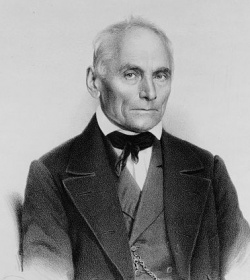 Lithograph of Purkyně by Rudolph Hoffmann, 1856, after a photograph by Bertsch & Aaraud, Paris. | |
| Born |
December 18, 1787 Libochovice, Bohemia, Austrian Empire |
|---|---|
| Died |
July 28, 1869 (aged 81) Prague, Austria-Hungary |
Jan Evangelista Purkyně (Johann Purkinje) was a 19th-century physiologist, anatomist, biologist, poet and philosopher. His experimental physiological investigations in the fields of histology, embryology and pharmacology helped to create a modern understanding of the eye and vision, brain and heart function, mammalian reproduction and the composition of cells. Purkyně created the world's first department of physiology and was one of the best known scientists of his time. He was a member of the Academies of Sciences in Berlin (1832) and Vienna (1860), of the Royal Society in London (1850), and corresponding member of the Academies of Sciences in St. Petersburg (1836) and Paris (1861).
Life
Early years
J. E. Purkyně was born on 17 or 18 December 1787 in Libochovice, a small village in northern Bohemia (then part of the Austrian Empire, now Czech Republic), as the first son of economic supervisor of the estate of Dietrichsteins, Josef (1746–29.9.1793) and Rosalia (born Šafránková, 1756–1834) Purkyně, followed by Emanuel (24.12.1789-28.5.1791) and Josef Jindřich (12.7.1793–1833). His father died suddenly in 1793. This affected the economic status of the family, and Jan's opportunity to acquire higher education was endangered.[1][2][3]
- Early studies
Jan received the foundations of general education in the Czech primary school of Libochovice. The inquisitive child widened his horizons by reading Comenius' Orbis Pictus. The local chaplain, Father Schiffner, was impressed by the child's intelligence and introduced him to Latin. He also taught him the Greek alphabet and spoke with him about astronomy. In the school Jan was introduced to music, both vocal and instrumental. He sang well and learned to play violin. As it turned out, these skills, especially singing, were of critical importance for the continuation of his education.[4][5]
In the spring of 1798, with the help of his mother's friends, Jan was accepted as a member of the church choir in Mikulov, southern Moravia. This enabled him to attend the school (later followed by his brother Josef), established for the Piarist order by Cardinal Dietrichstein, without paying the relatively high tuition fees. The language of instruction was German. The study program involved 3 years of the so-called normal school and 5-year gymnasium. At the gymnasium, the curriculum included Latin, Greek, history, and geography. In contrast to other comparable schools, at this gymnasium the Piarists paid substantial attention to philosophy, modern languages, mathematics, and physics. The Mikulov school had a rich collection of astronomical and physical apparatus. In its library he acquainted himself with the writings by G. Dobner and S. Konarski. There he probably found Schiller's poems, his lifelong passion. Jan did well in the normal school and was one of the best students at the gymnasium; he completed his studies there in 1804.[6][7]
In order to be able to continue his schooling, Purkyně applied for admission to the Piarist order, was accepted and adopted name Silverius. For his novitiate he journeyed to the monastery Stará Voda, near Olomouc, in north-central Moravia. Here he strengthened his knowledge of some subjects that were taught in the gymnasium and also learned French and Italian, completing his studies in two instead of three years. In 1805 he began to teach at the Piarist school (nižší gymnázium) in Strážnice (where Jan Amos Comenius studied in his time), southern Moravia, and in the following year he moved to the Piarist college in Litomyšl, eastern Bohemia. During the school year 1806–7 he simultaneously taught at the normal school and studied philosophy; the latter was at a school training future gymnasium teachers as well as students planning to study law, medicine, or theology. The library of the monastery of Olomouc offered rich treasures; among the major German thinkers, Kant remained unappealing to Purkyně whereas Schelling's Naturphilosophie [Philosophy of Nature] interested him throughout his life; however, it was Fichte who affected him most profoundly, especially through Einige Vorlesungen über die Bestimmung des Gelehrten [Some lectures on the mission of a scholar] (1794) and Uber die Bestimmung des Menschen zur unbeschränkten seelischen Freiheit [The call of men to an unlimited mental freedom] (1800).[8][9]
The German philosophers were not the most appropriate reading matter for a thoughtful young cleric who was a member in the Piarist order. Purkyně himself, in his midseventies, remembered the impact of Fichte’s philosophy as follows: "Having become somewhat familiar with the state of the newer literature in Germany and in other cultured countries and admiring their top contributors as well as getting to know the fate of my aging colleagues in the monastery, exhausted from an early age by strenuous teaching, I was frightened that a similar fate would await me as well"[10]. Fichte's philosophy vividly portrayed the mission of a true scholar in human society and rallied the human mind to an unlimited freedom. In combination with this familiarity with Fichte, Purkyně began to think of a different, happier life with enough strength to establish an independent position in the world: "Yes, the desire of glory strongly impelled me to follow my own path. Having been concerned in the monastery only with philological and historical studies, I turned first to poetry and then to philosophy whose spirit would free my mind. Yes, I felt deeply that I could achieve something significant in natural sciences, about which of course I had only a vague idea"[11]. These thoughts moved Purkyně to leave the Piarist order in August 1807, after which he took a pilgrimage walk home (Litomyšl, Vysoké Mýto, Přelouč, Praha, Radovesice, Libochovice). The chronicle of the monastery at Litomyšl contains a brief record of his decision: "Clericus Silverius Purkinie deserto Instituto nostro ad parentes Libochovicium migravit" (Having left our institution, the Clericus Silverius moved to his parents in Libochovice).[12][13]
First Prague period (1807–23)
- Studies
In Fall 1807 he began studies at the second year of philosophy at the University of Prague, where he began researching "sound images". He was making his living by tutoring in the families of barons Schuterstein and R. Weitenweber. During the summer holidays of 1808 Purkyně first met his lifelong friend Josef Jungmann in Litoměřice. Experiencing financial difficulties, after completing the third year of his studies (1809), he moved to Blatná and took up tutoring job of a son of baron Hildprandt (1810–13).[14][15]
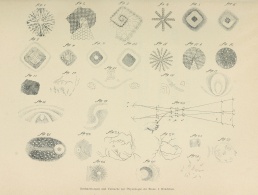
He returned to Prague in 1812 to study at the Medical Faculty of Charles University with Hildprandt's financial help, following lectures on anatomy by J. G. Ilge, later replaced by J. Rottenberger, as well as lectures on chirurgy by I. Fritz (becoming trainee at his clinic in 1816–18). During this time Purkyně was learning through experiments on himself what he missed in the studies, e.g. physiological changes during three-day long hunger strike, or processes of incipient freezing. On 30 November 1818 he defended his doctoral thesis Beiträge zur Kenntniss des Sehens in subjektiver Hinsicht (promoted on 9 December).[16][17] He was familiar with Goethe's Theory of Colours (1810) and confirmed with experiments some of his observations, previously refused as unscientific.[7](p39)
- Teaching
The years to come were full of intense studies and research concentrated on sensory organs and their functions. In January 1819 he joined the Department of Anatomy of the Prague University as prosector and research assistant of Prof Ilge and Prof Rottenberg. He unsuccessfully applied for professorships at several departments in Prague (pharmacology, 1820), Budapest (anatomy, 1820), Graz (anatomy and physiology, 1822), and Ljubljana (anatomy).[18][19]
- Professional affiliations and activities
With Josef Jungmann and Jan S. Presl he co-founded magazine Krok. He was a member of a secret society, most probably Illuminati.[20]
Traveled to Dresden in 1821. In 1822, together with Presl brothers, he secretly traveled to Leipzig to attend the First Congress of German Natural Scientists and Physicians (18–23 September). There he met state councillor Ch. F. Schulz (via Berlin professor J. N. Rust) who later introduced him to J. W. Goethe (Purkyně visited Goethe in Weimar on 10–12 December; Goethe in 1823 wrote in his letter to Count Sternberg on his address: "an unusually excellent man; an autodidactic and heautomorumentic spiritual and brilliant piarist"[21]. The two exchanged letters until Goethe's death in 1832[8].). He also met Karl Asmund Rudolphi, Berlin professor of anatomy and physiology, who personally intervened to Minister Altenstein for Purkyně's professorship in Breslau, Prussia (today Wrocław, Poland).[22][23]
Professorship in Breslau (1823–50)
In January 1823, King Friedrich IV of Prussia made Purkyně--against the strong opposition of the medical faculty--professor of physiology at the Medical Faculty of the University of Breslau. It was one of the most surprising university appointments of the time, for the young Czech had not even the title "Dozent" to his name and only a few little noticed publications.[24]
The 27 years spent in Breslau was the most fruitful period of his life. His intensive investigative charge and a wide action radius of research interests brought him a rich harvest of original results in various fields of physiology which today corresponds more to the concept of biology.[25][26]
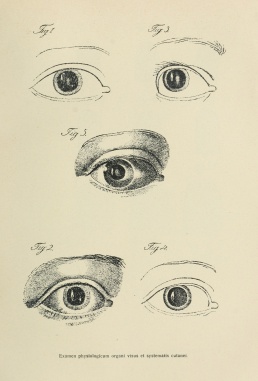
- Teaching
After visiting Berlin in March, on c10 April 1823 he began lecturing physiology (5 times a week) and pathology of eye a psychology (twice a week), although the lectures are poorly attended. Stayed in Bohemia in August–September. On 22 December he defended his habilitation thesis Commentatio de examine physiologico organi visus et systematis cutanei. In the opening sentences of his inaugural oration Purkyne declared his scientific worldview in modern terms: "The most important problem of a physician appears to me not his effort to renew a life already shattered, or to sustain a life a little longer, but efforts towards the support of evolving life; to protect it from harm; to bring it to the peak of perfection and beauty [..] The physician who assumes this task may be called an artist. Otherwise he merely performs the task of a repairman."[28] In 1824 he began supplying his lectures with demonstrations, so called experimental collegium; continued to research visual perception and published extensive work on this topic in Berlin, with dedication to Goethe.[29][30]
- Professional affiliations
In 1824 he joined Filomatic Society where the Czech literature was often discussed.[31] That same year, he was accepted to Silesian Society for Patriotic Culture (Slezská vlastenecká společnost, Schlesische Gesellschaft für Vaterländische Kultur) where until 1850 he delivered over 60 reports about almost all of his works and inventions.[32]
In Summer 1826 he was accepted as an apprentice at a masonic lodge of Berlin which counted many influential physicians and civil servants among its members. He spent several months in Berlin. A year later he was appointed fellow and soon master.[33]
In October 1829 Purkyně was elected a member of Emperor Leopold Academy of Natural Sciences (Academia Caesarea Leopoldino-Carolina Naturae Curiosorum, today Leopoldina)[9], next year adopting name Darwin I. (in honor of Erasmus Darwin, grandfather of Charles Darwin).[34][35]
- Working travels
In September 1826 he participated in the Congress of German Natural Scientists and Physicians in Dresden. He also took part in other editions: 18–23 September 1828 in Berlin where he met Ernst Heinrich Weber, Karl Ernst von Baer, Johannes Peter Müller, Anders Jahan Retzius and others; September 1833 in Breslau (visits of Retzius, R. Brown, Jan Svatopluk Presl, František Palacký); 18–23 September 1837 in Prague where he discussed with Jan Svatopluk Presl about the ways to transform the Prague Museum into Academy of Sciences.[36][37]
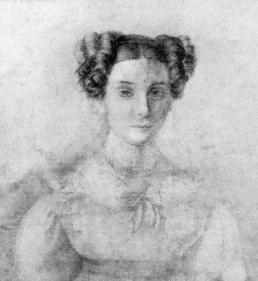
- Family
He got closer to Karl Rudolphi's family, eventually marrying his daughter Julia Agnes Rudolphi (herself Protestant, born 1800) on 24 September 1827 (kids: Rosalie, 10.2.1829–29.8.1832; Johanka, 1830–29.8.1832, both died of cholera; Emanuel, 17.12.1831–82, professor of natural sciences, botanist and meteorologist[10]; Karel, 11.3.1834–5.4.1868, painter [11]). Julie fell victim to a typhoid epidemic on 12 February 1835; he never remarried, but his house was always open to political exiles and impecunious scholars.[38][39]
- Honors
In 1833 he received Montyon award in France for his monography De cellulis antherarum fibrosis nec non de granorum pollinarium formis commentatio phytotomica (1830).[40]
- Political activism
In Breslau he founded Towarzystwo Literacko-Słowiańskie [Literary-Slav Society] (1836), and promoted national and political awareness.[41][42] In 1848 he participated in the Slavic Congress in Prague, for which he was criticised by journalists in Breslau.[43]
- Breslau's Physiological Institute
In preparation since his early days in Breslau, and in 1836 approved by minister, in 1839 he founded the department of physiology (first in central Europe) in a newly reconstructed shed in the garden of the Academy on Katerina Street (opened on 8 November), since 1842 known as the Physiological Institute.[44][45]
- Poetry translations
In 1841 he published two volumes of translations of Schiller's poems to the general acclaim in Breslau, however criticised in Prague (Karel Havlíček). He also collaborated on Polish translation of Ohlasu písní českých by František Ladislav Čelakovský, and wrote for magazines about the Russian literature.[46]
Second Prague period (1850–69)
In 1849, after initiative of Minister of Education Lev Thun-Hohenstein, Purkyně was appointed professor of physiology at the Prague Medical Faculty (emperor passing a decree on 4 November). Back in Prague, he was eagerly engaging in national enlightenment (lecturing in Czech already between 1850–53), cultural and organizatory activities. Until his last days he remained appreciated and admired by the public, and restlessly active. He began lecturing in April 1850.[47][48]
- Prague's Physiological Institute
As soon as in 1851 he founded the Prague's physiological institute. Although his proposed locations were Klementium and Franciscan monastery on Jungmann Square, the institute found its home in a private apartment in Spálená street. Purkyně opened it on 6 October with the words: "Life entered into the world of inorganic things in order to follow Nature's laws not to disturb them."[49] He himself moved to the second floor in the house.[50]
- Živa
Purkyně was named chairman of the Natural Sciences Committee of Czech Museum at its foundational meeting in October 1852. There he also proposed to start publishing a Czech magazine on natural sciences with its first issue appearing already in January 1853 under the name Živa, edited by Purkyně and the geologist Jan Krejčí, and published until today [12] (despite pauses between 1864–67, 1868–91 and 1915–53). Although the committee stopped functioning in 1858 its legacy was taken over by Živa, which also became publishing platform for young natural scientists from Purkyně's Physiological Institute.[51]
- Representative positions
Between 1852–58 he was curator of the Committee for Education in Language and Literature of Matice česká. In 1854 he is appointed director of Královská česká společnost nauk [Royal Czech Society of Sciences]. Later he was named director (1857–59) of the first Czech industrial school he helped to found. He was named chairman of the Society of Czech Doctors at its foundational meeting in July 1862, with Purkyně using it as his main platform for struggle for reintroduction of Czech language in the Medical Faculty. In 1863 he was named vice-chairman of the newly founded Umělecká beseda; there he launched the Committee for natural-scientific research of Bohemia.[52]
- Purkyně's closest social circle in Prague
Ladislav Čelakovský moved in to his house in 1852 after death of his father, a poet. In 1855, young botanist Julius Sachs moved from Breslau to Prague and stayed at his home while pursuing his studies; he later worked for Purkyně as his personal assistant and drawer, publishing a number of bonatical works in Živa [13]. Purkyně's assistants included Eduard Grégr (1855–58) who was interested mostly in comparative physiology and anthropology, Antonín Frič (1861–63), and Johann Nepomuk Czermak (Jan Čermák; brother of painter Jaroslav Čermák; later professor of physiology at universities in Krakow and Leipzig).[53]
Purkyně's home served as a refuge meeting place of the Czech artists (esp. since 1857); he was a friend of poets Vítězslav Hálek, Jan Neruda and Pavel Jozef Šafárik, writers Božena Němcová and Karolina Světlá, painters Jaroslav Čermák, Mánes brothers and Maixner brothers, and philantropist Vojtěch Náprstek among others.[14] His friendship with many influential Austrian aristocrats stood him in good stead and the Austrian police authorities were never quite certain whether he was a dangerous " subversive element" or, according to a later assessment in his secret dossier, "an eccentric humanist who does not constitute a danger to State interests."[54] However in 1857 he got under police surveillance and was forced to quit his membership in the masonic lodge of Berlin.[55]
- Working travels
In July 1856 he visited the World Exposition in Paris, met M. J. P. Flourens and Jaroslav Čermák who painted his portrait.[56] After being named a member of the Academy of Sciences in Vienna (1860) he regularly took part at its meetings (30 May 1861, June 1864, c20 May 1866). He also visited Vienna on other occassions (13.5.1856, 26.5.1859, 25.5.1865, 27.5.1867). In 1865 he participated in the Congress of Hungarian Doctors and Natural Scientists in Pressburg (29 August–2 September).[57]
- Political activities
In March 1861 Purkyně was elected a member of the Czech Landtag (Český zemský sněm, Böhmische Landtag) in Slánsko, Velvary and Libochovice county. In his speech delivered on 11 April he demanded freedom of speech and freedom of press. His mandate ended on 21 December 1866. In 1867 he published political fable Austria polyglotta with his proposal for solution of national question in the Austrian monarchy following the Austro-Hungarian Compromise.[58][59]
Death and legacy
He died in 1869 in Prague after a long illness, and was buried in the Czech National Cemetery in Vyšehrad, Prague.[15]
Živa: Magazine for Popularization of Biology he founded in 1853 is published up to this date, by the Czech Academy of Sciences.[16] The issue 5/2011 was dedicated to his work (in Czech, available online).
The university in Ústí nad Labem is named after him (since 1991) and counts the Faculty of Art and Design (since 1993).
His contribution to the arts was discussed at the Excavating the Future: An Archeology and Future of Moving Pictures event initiated by Jaroslav Anděl in Prague (2001), and in the studies by Anděla Horová (1989)[60] and Lada Hubatová-Vacková (in Czech, 2005)[61]. Roman Prahl organised the exhibition "Jan Evangelista Purkyně a výtvarné umění" [Jan Evangelista Purkyně and Fine Arts] at the Convent of St Agnes of Bohemia in Prague in 1987.
Work
Purkyně contributed mainly to physiology, morphology, and psychology, but as well to anthropology (e.g. by constructing goniometer), botany, and zoology.
- Images of sound waves, synaesthesia (1808–23)
As a philosophy student in Prague, Purkyně studied synaesthetic phenomena, e.g. phantom visual perception stimulated by sound and methods for capturing phenomena at the borderline of merging perceptions through different senses. He discussed these phenomena in his Dissertation (1819) and in letters with Goethe. Inspired by Ernst Chladni's sound figures (tonal vibrations visible in fine sand, also known by Goethe and Runge) he discovered similar structures in his microscopic studies of the eye.[17](p39) He experimented with sound analysis; and measured the wavelength on the sound images attached to vibrating glass plates.
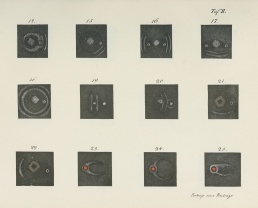
- Visual perception (1818–25)
Later, as a medic, Purkyně studied various subjective visual phenomena, including pressure, light-shade, galvanic and vascular patterns (branching blood vessels in his own eye); patterns emerging from glare; feelings in the dark (phosphenes); representations of blind spots; unity of the visual fields of both eyes; double vision; indirect vision; color blindness of peripheral parts of the retina; Purkinje effect (sometimes called "Purkinje shift", change in the relative luminosity of colors when eye is adapting to the darkness; e.g. when light intensity decreases, red objects seems to fade faster than blue objects of the same brightness)[18]; light tracks; and after images.
- Method for objective investigation of the eye (1823)
He proposed a method for continuous objective investigation of the eye, which is noteworthy particularly for its use of reflective images. The candle flame (or other object) is reflected from the structure of the eye four times: on the outer and inner surfaces of the cornea, and on the anterior and posterior surface of the lens. Purkyně highlighted the use of these reflective images (today known as Purkinje-Sanson images, or Purkinje reflexes, or catoptric images) to measure the curvature of the cornea (the principle of keratometry and ophthalmometry)[19] and their further use for diagnostics of diseases and disorders of the eye; described his observation of the frontal segment of the eye in an oblique focal illumination and by biomicroscopy of the eye (later Gullstrand principle); and observed fluorescence of the eye and came up with the method of observing the back of the eye in vivo, which later served as the principle of ophthalmoscopy established in 1850 by Hermann von Helmholtz.[20]
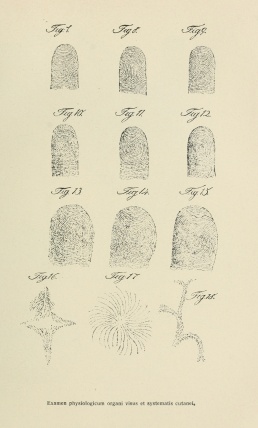
- Investigation of the skin surface (1823)
Purkyně published a thesis that recognised 9 principal configuration groups of fingerprints (in the late 19th century Francis Galton used these patterns as the basis of a fingerprint classification system that could identify specific individuals); also observing the skin capillaries in vivo.
- Physiological practice (1823)
Purkyně stressed the importance of the constitution in medicine, which is also related to differences among healthy individuals, and the need for individualization in the examination and assessment of patients. He also pointed to the importance and need for preventive aspects in medicine and the role of physiology in maintaining health care.
- Studies of hearing (1824–62)
Combination tones (so called Tartini's third tones, 1824) are of subjective origin; the possibility of locating the amplitude of the vibrating plate by auscultation with a special tool (predecessor of the stethoscope, 1825). Later he was interested in locating the direction of the sound, the bone conduction, use of hearing aids to amplify sound for people experiencing hard-of-hearing (1859–62). These studies were well received.
- Physiology of human speech (1827–65)
Differentiation between phonation organs (larynx) and resonant spaces; attempt to sort phones in terms of articulation and acoustics; use of the acquired knowledge to improve speech and correcting its defects. Early work in the field of phonetics, German manuscript was lost in the Berlin Academy, discovered only in 1960.
- Perception of space and movement (1827–53)
Purkyně distinguished between subjective and objective visual space (1827, 1837). Spatial perception using other senses (1840, 1853). In order to represent motion, Purkyně used his own version of zoetrope which he called forolyt (1840) and kineziskope which he improved as well. He put nine photos of him shot from various sides to the disc and entertained his grandchildren by showing them how he, an old and famous professor, is turning around at great speed.
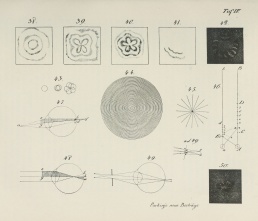
- Other research
Vertigo - body posture - maintaining balance (1820–27); The consequences of experimental braina and cerebellum injury (1824–26); Drug testing - physiological pharmacology (1820–29); Development of the chicken egg before hatching (1825–30); Plant structures (1828–30); Microscopic composition of animal tissues (when after seven-years war with the authorities he was allowed to buy a "large" achromatic Plössl microscope[62], 1832–45), including discovery of Purkinje cells (large neurons with many branching dendrites found in the cerebellum, 1837), making him the co-founder of cell biology, and Purkinje fibres (the fibrous tissue that conducts electrical impulses from the atrioventricular node to all parts of the ventricles of the heart, 1839); Embryology (1825–37); Ciliary movement (1833–36); Digestion in vitro (1835–37); Functional morphology (1839–45); Physiological basis of sleep and wakefulness (1846–49).
Notes
- ↑ Franta 2011, p. 198
- ↑ Kruta 1985
- ↑ WadeBrožek 2001, p. 27
- ↑ WadeBrožek 2001, p. 27
- ↑ Franta 2011, p. 198
- ↑ WadeBrožek 2001, p. 27
- ↑ Franta 2011, p. 198
- ↑ WadeBrožek 2001, pp. 27-28
- ↑ Franta 2011, p. 198
- ↑ Rieger 1867, p. 1115
- ↑ Rieger 1867, p. 1115
- ↑ WadeBrožek 2001, p. 28
- ↑ Franta 2011, p. 198
- ↑ Franta 2011, p. 198
- ↑ Kruta 1985
- ↑ Franta 2011, p. 198
- ↑ Kruta 1985
- ↑ Franta 2011, p. 198
- ↑ Kruta 1985
- ↑ Franta 2011, p. 198
- ↑ Posner 1969, p. 107
- ↑ Franta 2011, p. 198
- ↑ Kruta 1985
- ↑ Posner 1969, p. 107
- ↑ Franta 2011, p. 198
- ↑ Kruta 1985
- ↑ John 1959, p. 61
- ↑ Posner 1969, pp. 107-108
- ↑ Franta 2011, pp. 198-9
- ↑ Kruta 1985
- ↑ Franta 2011, pp. 198-9
- ↑ Kruta 1985
- ↑ Franta 2011, p. 199
- ↑ Franta 2011, p. 199
- ↑ Kruta 1985
- ↑ Kruta 1985
- ↑ Franta 2011, p. 199
- ↑ Franta 2011, p. 199
- ↑ Kruta 1985
- ↑ Franta 2011, p. 199
- ↑ Franta 2011, p. 199
- ↑ Kruta 1985
- ↑ Franta 2011, p. 199
- ↑ Franta 2011, p. 199
- ↑ Kruta 1985
- ↑ Franta 2011, p. 199
- ↑ Franta 2011, p. 199
- ↑ Kruta 1985
- ↑ Posner 1969, p. 109
- ↑ Franta 2011, p. 199
- ↑ Franta 2011, p. 199
- ↑ Franta 2011, p. 199
- ↑ Franta 2011, p. 199
- ↑ Posner 1969, p. 109
- ↑ Franta 2011, p. 199
- ↑ Kruta 1985
- ↑ Kruta 1985
- ↑ Franta 2011, p. 199
- ↑ Kruta 1985
- ↑ Horová 1989
- ↑ Hubatová-Vacková 2005
- ↑ Posner 1969, p. 108
Literature
- Writings by Purkyně
- Beobachtungen und Versuche zur Physiologie der Sinne, Bd 1: Beiträge zur Kenntniss des Sehens in subjectiver Hinsicht [Observations and Experiments on the Physiology of the Senses, Vol. 1: Contributions to the Knowledge of Vision in its Subjective Aspect], Prague: Calve, 1819, 176 pp. Disseration thesis. (in German) [21] [22] [23]
- Trans., Příspěvky k poznání zraku ze subjektivního hlediska, by Vladislav Kruta, Brno, 1969. (in Czech)
- Trans., Observations and Experiments on the Physiology of the Senses. Contributions to the Knowledge of Vision in its Subjective Aspect, in Nicholas J. Wade, Josef Brožek, Purkinje's Vision: The Dawning of Neuroscience, Mahwah, NJ: Lawrence Erlbaum Associates, 2001, pp 61-102. (in English)
- Commentatio de examine physiologico organi visus et systematis cutanei [Contributions to Physiological Research of Sight and Skin System], Wrocław: University of Wrocław, 1823. Doctoral thesis. (in Latin) [24]
- Beobachtungen und Versuche zur Physiologie der Sinne, Bd 2: Neue Beiträge zur Kenntniss des Sehens in subjectiver Hinsicht [Observations and Experiments on the Physiology of the Senses, Vol. 2: New Contributions to the Knowledge of Vision in its Subjective Aspect], Berlin: Georg Reimer, 1825, 192 pp. (in German) [25]
- Symbolae ad ovi avium historiam ante incubationem, Wrocław, 1825. (in Latin) [26] [27] [28]
- De cellulis antherarum fibrosis nec non de granorum pollinarium formis commentatio phytotomica, Wrocław: Gruesonius, 1830, 58 pp. (in Latin) [29] [30]
- with Gabriel Gustav Valentin, De phaenomeno generali et fundamentali motus vibratorii continui in membranis cum externis tum internis animalium plurimorum ... obvii. Commentatio physiologica, Wrocław: Aug. Schulz, 1835. (in Latin) [31] [32] [33] [34]
- Papierstreifen aus dem Portefeuille eines verstorbenen Naturforschers, 1850. (in German) / Útržky ze zápisníku zemřelého přírodovědce, Prague: Mladá fronta, 1987. (in Czech)
- Ueber den Begriff der Physiologie, ihre Beziehung zu den übrigen Naturwissenschaften, und zu andern wissenschaftlichen und Kunst-Gebieten, die Methoden ihrer Lehre und Praxis, über die Bildung zum Physiologen, über Errichtung physiologischer Institute: Rede, gehalten bei der Eröffnung des physiologischen Institutes zu Prag am 6. October 1851, Prague, 1851, 24 pp. (in German)
- Akademia, Prague: Živa, 1861, 72 pp. (in Czech)
- Austria polyglotta, Prague: dr Edv. Grégr, 1867, 44 pp. (in Czech, German) [35]
- Vzpomínky Jana Ev. Purkyně na vlastní mládí v Libochovicích prožité, Libochovice: D. Mayer, 1887, 48 pp. (in Czech)
- Ústřední topení a větrání, Vol. 1, Prague: Česká matice technická, 1900, 173 pp. (in Czech)
- Opera omnia, collected works, 13 volumes, Prague: Society of Czech Physicians (Vol. 1), State Health Publishing House (Vols. 2-6), Academia (Vols. 7-13), 1918-1985. (in Czech, German, Latin, Polish, Russian, Serbian)
- Sebrané spisy, Volume 1, edited by K.J.Lhotak, Prague: Society of Czech Physicians, 1918. Includes 6 works from 1819-35. (in German, Latin)
- Opera selecta, edited by Z.Frankenberger, K.Hübschmann, F.Karasek, V.Kruta, V. Laufberger, and F.K.Studnička, Prague. Association of Czech Medical Men, 1948.
- Jana Ev. Purkyně Korespondence I, Prague: Unie, 1920, 249 pp. (in Czech)
- Jana Ev. Purkyně Korespondence II, Prague: Spolek čes. lékařů, 1925, 250 pp. (in Czech)
- Jan Thon (ed.), Básnický glosář Jana Evangelisty Purkyně, Prague: Státní nakladatelství krásné literatury, hudby a umění, 1959, 455 pp. (in Czech)
- Jan Thon (ed.), Básně a překlady, Prague, 1968. (in Czech)
- Published by Purkyně
- F. Wł. Czelakowski, Odgłos pieśni czeskich, Trans. A. Szukiewicz, 1840, 113 pp. (in Polish) [36]
- Arnošt Šulc, Okauzlená růže, Trans. Josef Kačer, Wrocław, 1840, 105 pp. (in Czech)
- Bedřich Šiller, Básně lyrické 1, Trans. Jan Purkyně, Wrocław, 1841, 208 pp. (in Czech)
- Bedřich Šiller, Básně lyrické 2, Trans. Jan Purkyně, Wrocław, 1841, 192 pp. (in Czech)
- On Purkyně
- J. Goethe, "Das Sehen in subjectiven Hinsicht, von Purkinje, 1819", Zur Naturwissenschaft überhaupt, besonders zur Morphologie, Stuttgart: Cotta, 1824, pp 102–177.
- Rieger, F.L. (1867). "Jan Evangelista Purkinje". Dictionary, Vol. 6. Prague: Kober. pp. 1115–1119 (Czech)..
- Emanuel Rádl, Jana Ev. Purkyně práce histologické, Prague: Král. čes. společ. nauk, 1900, 51 pp. (in Czech)
- Ethel Mary Chamberlain, A Study of the Purkinje phenomenon with spectral lights, University of Chicago, 1911. Dissertation.
- Karel Amerling, Jan Evangelista Purkyně: badatel, reformátor a buditel, Prague: F. Topič, 1918, 73 pp. (in Czech) [37]
- Karel Chodounský, Jan Evang. Purkyně: Působení jeho pro rozvoj české kultury, Prague: Č ak. věd a umění, 1927, 180 pp. (in Czech)
- Růžena Pokorná-Purkyňová, "U Purkyňů před sto lety", Rozpravy Aventina, 1931, Vol. 6, No. 30, p 350.
- Johannes Urzidil, Goethe und J.E. Purkyně. Teil 1, Prague, 1937, 443 pp. (in German)
- Jarmila Psotníčková, Rodokmen J.E. Purkyně, Prague: Purkyňova společnost, 1937, 24 pp. (in Czech)
- Franz Krause, Weg und Welt des Goetheanisten Johannes Evangelista Purkyně (in German). Trans. Goethovec Jan Evangelista Purkyně, Prague: Anthroposofická společnost v republice Československé, 1937, 31 pp. (in Czech)
- Miloslav Matoušek, Jan Evangelista Purkyně: životopisný nástin, Prague, 1937, 23 pp. (in Czech)
- Růžena Pokorná-Purkyňová, Život tří generací, Prague, 1944. Commented correspondece of Purkyně family. (in Czech)
- Miloslav Matoušek, Život Jana Evangelisty Purkyně, Prague: Práce, 1946, 81 pp. (in Czech)
- Mikuláš Teich, Jan Evangelista Purkyně, Brno: Rovnost, 1950, 25 pp. (in Czech)
- R. Skopec, "Jan Evangelista Purkyně a fotografie", Nová fotografie, No 11, 1952, p 122. (in Czech)
- Oldřich Vilém Hykeš, J.Ev. Purkyně: 1787-1869, Prague: Orbis / Naše věda, technika, umění a jejich představitelé (materiál k nástěnkám), 1953, 7 pp. (in Czech)
- J. Brichta, "Purkyňův přínos k vynálezu kinematografie", Vesmír, 1953, pp 250-253. (in Czech)
- R. Skopec, "Jan Evangelista Purkyně a fotografie", ČsF, No 9, 1955, p 102. (in Czech)
- Otakar Matoušek, Bohumil Němec (eds.), Jan Evangelista Purkyně: Badatel - národní buditel: Soubor příspěvků o jeho životě a práci, Prague: Čs. akademie věd, 1955, 250 pp. (in Czech)
- Eva Rozsívalová, Život a dílo J.E. Purkyně, Prague: ČSAV, 1956, 144 pp. (in Czech)
- Jarmila Psotníčková, Jan Evangelista Purkyně: Soubor obrazů a dokumentů, Prague: Orbis / Obrazové publikace, 1955, 47 pp. (in Czech)
- John, H.J. (1959). Jan Evangelista Purkyně: Czech Scientist and Patriot 1787–1869. Philadelphia, PA: American Philosophical Society.
- O. Matousek, "J.E.Purkyněs Leben und Tätigkeit im Lichte der Berliner und Prager Archive", Nova Acta Leopoldina, 24 (1961), pp 109–129. (in German)
- Vladislav Kruta, Jan Evangelista Purkyně, Prague: SZdN, 1962, 127/143/143/142/142/147 pp. (in Czech, English, German, French, Spanish, Russian)
- Olga Macková (ed.), Karel Purkyně 1834-1868: Souborná výstava díla, Prague: National Gallery, 1962, 50 pp.
- Vladislav Kruta, K počátkům vědecké dráhy J.E. Purkyně: Korespondence s přáteli z pražských let 1815-1823, Prague: SPN / Sborník prací lék. fak. v Brně, 1964, 207 pp. (in Czech)
- Vladimír Smetana, Jan Evangelista Purkyně 1787-1967, Prague: Encyklopedický institut ČSAV, 1967, 27 pp. (in Czech)
- Vladislav Kruta, The Poet and the Scientist: Johann Wolfgang Goethe - Jan Evangelista Purkyně, Prague: Academia, 1968, 44/46 pp. (in English, Czech)
- Vladislav Kruta, J.E. Purkyně (1787-1869) Physiologist: A Short Account of his Contributions to the Progress of Physiology with a Bibliography of his Works, Prague: Academia, 1969, 137 pp.
- Posner, E. (1969). "J. Evangelista Purkyně (1787-1869)". British Medical Journal (3): 107-109.
- Vladimir Kruta (ed.), Jan Evangelista Purkyně 1787–1869. Centenary symposium, Brno: Universita Jana Evangelisty Purkyně, 1971. (in Czech)
- Václav Spěváček, J.E. Purkyně a západní Čechy, Pilsen: Západočes. nakl, 1972, 109 pp.
- Ivan Kubišta, Purkyně ve Vratislavi, 3rd edition, 1974, Prague: Mladá fronta, 335 pp. (in Czech)
- Kruta, Vladislav, ed. (1985). Jan Evangelista Purkyně: Sebrané spisy, Vol. XIII. Prague: Academia (Czech). [38]
- E. Trávníčková (ed.), Jan Evangelista Purkyně. Život a dílo, Prague: Avicenum, 1986. (in Czech)
- Josef Brožek, Jiří Hoskovec, J. E. Purkyně and Psychology: With a Focus on Unpublished Manuscripts, Prague: Academia, 1987, 137 pp.
- Libochovice - město Jana Evangelisty Purkyně: sborník vydaný k 200. výročí narození velkého českého vědce a buditele, Libochovice: Městský národní výbor, 1987, 36 pp. (in Czech)
- Václav Žáček, Jan Evangelista Purkyně, Melantrich, 1987, 363 pp. (in Czech)
- Josef Haubelt, Jan Evangelista Purkyně, Prague: Horizont, 1987, 139 pp. (in Czech)
- Jana Jakrlová, Josef Sajner, "J.E. Purkyně jako ilustrátor vlastních vědeckých prací", Vesmír 7, 1987, pp 379-382. (in Czech)
- Horová, Anděla (1989). "Jan Evangelista Purkyně a dějiny výtvarného umění". Estetika 26 (1): 116-121 (Czech).; English trans. in Jan Evangelista Purkyně in Science and Culture, 1988, pp 197-209.
- Jaroslav Purš (ed.), Jan Evangelista Purkyně in Science and Culture: Scientific conference, Prague, August 26-30, 1987, Prague: Ústav československých a svĕtových dějin Československé akademie věd, 1988. 2 volumes. (in English, Czech, Russian)
- J. Kröhn, "Purkyňův kinesiskop", Věda, technika a my, No 7, 1994, p 7. (in Czech)
- Wade, Nicholas J.; Brožek, Josef (2001). Purkinje's Vision: The Dawning of Neuroscience. Mahwah, NJ: Lawrence Erlbaum Associates.. Includes English translation of Purkyně's dissertation.
- Stezka Jana Evangelisty Purkyně, Moravský Beroun: Moravská expedice / Do nitra Askiburgionu, 2003, 118 pp. (in Czech)
- Hubatová-Vacková, Lada (2005). Vnitřní zrak: Jan Evangelista Purkyně, laboratoř vizuality a moderní umění. Prague: Centre for Theoretical Studies (Czech).; other version published in Umění/Art, No. 6, Vol. 53 (2005), pp 566-585, PDF.
- Siegfried Zielinski, "Electrification, Tele-Writing, Seeing Close Up: Johann Wilhelm Ritter, Joseph Chudy, and Jan Evangelista Purkyně", in Deep Time of the Media: Toward an Archaeology of Hearing and Seeing by Technical Means, MIT Press, 2006, pp 159-204.
- Živa 5: Special Issue on J. E. Purkyně, 2011. (in Czech)
- Franta, Jan (2011). "Jan Evangelista Purkyně – významná životopisná data". Živa (Prague: Academia) (5): 198–199. ISSN 0044-4812 (Czech).
- Irina Melnik, Jan Evangelista Purkyně: životopisný komiks k výstavě Národního muzea Vynálezci a vynálezy konané od 27.9.2011 do 1.5.2012, Prague: National Museum, 2011, 12 pp. (in Czech) Exhibition
